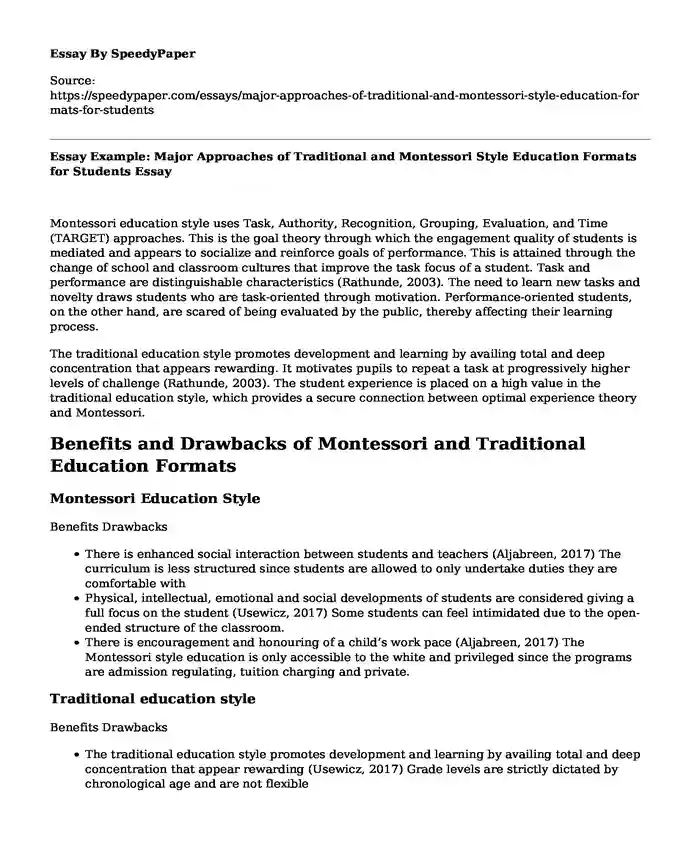
| Essay type: | Compare and contrast |
| Categories: | Learning Child development Comparative literature Essays by pagecount |
| Pages: | 2 |
| Wordcount: | 396 words |
Montessori education style uses Task, Authority, Recognition, Grouping, Evaluation, and Time (TARGET) approaches. This is the goal theory through which the engagement quality of students is mediated and appears to socialize and reinforce goals of performance. This is attained through the change of school and classroom cultures that improve the task focus of a student. Task and performance are distinguishable characteristics (Rathunde, 2003). The need to learn new tasks and novelty draws students who are task-oriented through motivation. Performance-oriented students, on the other hand, are scared of being evaluated by the public, thereby affecting their learning process.
The traditional education style promotes development and learning by availing total and deep concentration that appears rewarding. It motivates pupils to repeat a task at progressively higher levels of challenge (Rathunde, 2003). The student experience is placed on a high value in the traditional education style, which provides a secure connection between optimal experience theory and Montessori.
Benefits and Drawbacks of Montessori and Traditional Education Formats
Montessori Education Style
Benefits Drawbacks
- There is enhanced social interaction between students and teachers (Aljabreen, 2017) The curriculum is less structured since students are allowed to only undertake duties they are comfortable with
- Physical, intellectual, emotional and social developments of students are considered giving a full focus on the student (Usewicz, 2017) Some students can feel intimidated due to the open-ended structure of the classroom.
- There is encouragement and honouring of a child’s work pace (Aljabreen, 2017) The Montessori style education is only accessible to the white and privileged since the programs are admission regulating, tuition charging and private.
Traditional education style
Benefits Drawbacks
- The traditional education style promotes development and learning by availing total and deep concentration that appear rewarding (Usewicz, 2017) Grade levels are strictly dictated by chronological age and are not flexible
- The teacher delivers a lesson in similar order and pace for all students. (Aljabreen, 2017)
- The needs of the students do not determine traditional curricula.
- There are standardized grades and performance of tests (Usewicz, 2017)
- Lectures are usually orated to students that take tests, memorize and listen passively.
References
Aljabreen, H. (2017). A comparative multi-case study of teacher roles in US Montessori preschool and Saudi public preschool (Doctoral dissertation, Kent State University).
Rathunde, K. (2003). A comparison of Montessori and traditional middle schools: Motivation, quality of experience, and social context. Namta Journal, 28(3), 12-53.
Usewicz, C. (2017). Choice-Based Art in the Middle School Classroom.
Cite this page
Essay Example: Major Approaches of Traditional and Montessori Style Education Formats for Students. (2023, Sep 28). Retrieved from https://speedypaper.com/essays/major-approaches-of-traditional-and-montessori-style-education-formats-for-students
Request Removal
If you are the original author of this essay and no longer wish to have it published on the SpeedyPaper website, please click below to request its removal:
- Free Essay on Infection Control in a Dental Clinic
- Free Essay on Social Media and Young Generation in American
- The Functions of the INTERPOL, Free Essay for Students
- Gag Reflex - Essay Sample for Your Inspiration
- Women and Imprisonment within Jane Eyre, Essay Sample
- Essay Sample on Trade Between Asia and Western Cultures
- Reflective Essay on Plagiarism
Popular categories




